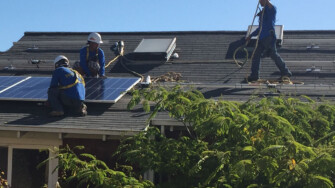California Rooftop Solar
Making rooftop solar accessible and affordable for all Californians

Rooftop solar can help create a climate-safe California. As California adds more rooftop solar, the need for fossil gas power plants that power homes and businesses decreases, helping to improve air quality in communities located near power plants. Installing rooftop solar can also help Californians lower their monthly energy bills. That’s because every kilowatt of power they get from the sun is a kilowatt they don’t have to buy from their utility company. Rooftop solar can also help keep the lights on during power outages using backup batteries that store energy for later use.
California now has more than 1 million solar rooftops because of a policy that made them affordable for Californians. Net Energy Metering, or NEM, refers to the rates that solar owners receive from their utility compensating them for surplus power they feed to the grid. These rates are regulated by the California Public Utilities Commission (CPUC) and used to help make rooftop solar affordable for all Californians, including working-class families.
Solar for California’s single-family residences
The most recent “NEM 3.0” policy for single-family residences is a corporate utility giveaway that’s bad for California residents and businesses. Despite enormous public opposition, including from The Climate Center, this policy took effect on April 15, 2023. NEM 3.0 will likely slow solar adoption across California. However, over the life of the system, electricity from rooftop solar still costs less than paying for utility electricity in California.
The biggest problem with NEM 3.0 is that it imposes a drastic 75 percent cut to the amount that corporate utilities pay their customers for the clean solar power they feed to the grid. This substantially reduces the overall savings benefit of installing solar and extends the amount of time it takes to break even on the investment.
Right at a time when more lower- and middle-income households were starting to install solar, this dramatic change will relegate solar once again to higher-income households that can also pair their solar with expensive battery storage in order to maximize their long-term savings.
Solar for California’s renters, farms, and schools
In addition to NEM 3.0 for single-family residences, other solar policies determined by the CPUC apply to multi-unit dwellings, as well as schools, farms, and other locations where there may be more than one meter serving the location. Working-class and frontline communities have suffered too long from air pollution, climate change, skyrocketing utility bills, and blackouts. In the last few years, California regulators have at times proposed plans that are more beneficial to corporate utilities than to working-class communities. Going forward, these regulators must put the needs of California’s 16 million renters above the demands of corporate utilities in designing rooftop solar policies.


